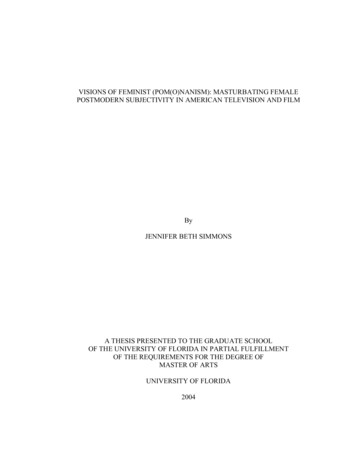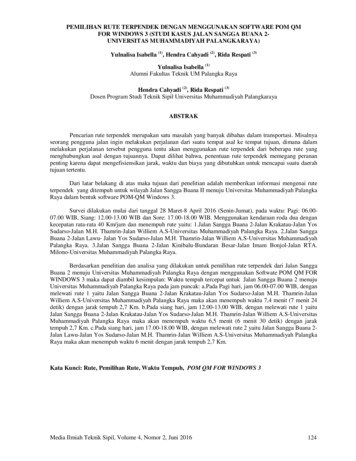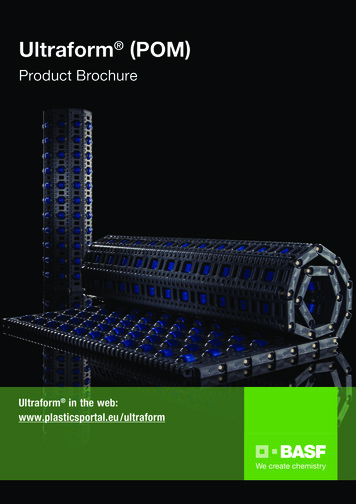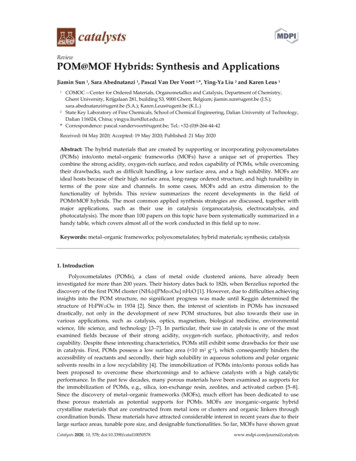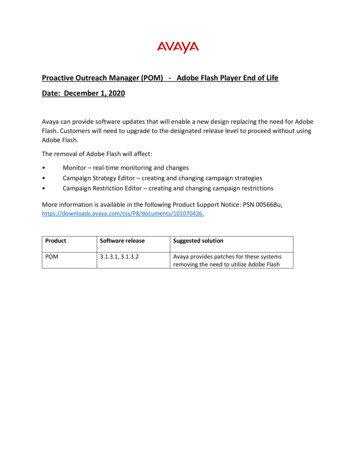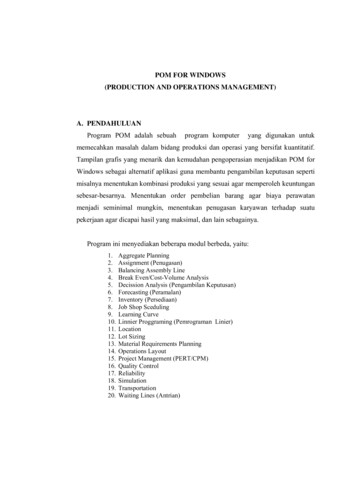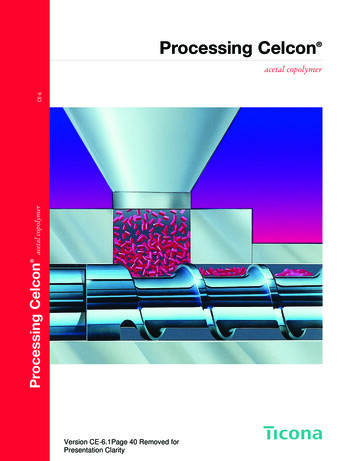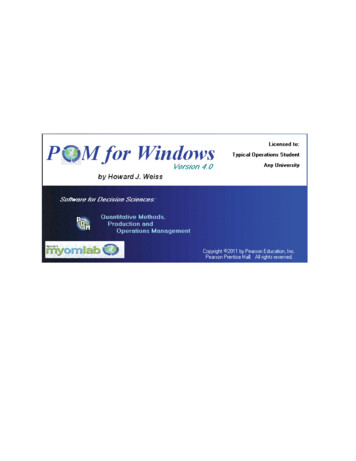
Transcription
POM - QM FOR WINDOWSVersion 4Software for Decision Sciences:Quantitative Methods,Production and Operations ManagementHoward J. all.comOctober 1, 2010Copyright (c) 2011 by Pearson Education, Inc., Upper Saddle River, New Jersey, 07458.Pearson Prentice Hall. All rights reserved.
Table of ContentsChapter 1: IntroductionOverview . 1Hardware and Software Requirements . 3Installing the Software . 4The Program Group . 5Starting the Program . 6The Main Screen . 7Chapter 2: A Sample ProblemIntroduction . 12Creating a New Problem . 13The Data Screen . 15Entering and Editing Data . 15The Solution Screen . 17Chapter 3: The Main MenuFile . 19Edit . 25View . 26Module . 27Format . 28Tools. 30Window . 31Help . 32Chapter 4: PrintingThe Print Setup Screen. 37Information to Print. 38Page Header Information . 39Page Layout. 40Printer Options . 41v
POM-QM for WindowsChapter 5: GraphsIntroduction . 43File Saving . 44Print . 44Colors and Fonts . 45Chapter 6: ModulesOverview . 45Aggregate (Production) Planning. 46Assembly Line Balancing/Line Balancing. 57The Assignment Model . 65Breakeven/Cost-Volume Analysis . 67Capital Investment/Financial Analysis . 71Decision Analysis. 73Forecasting . 84Game Theory. 99Goal Programming . 102Integer and Mixed Integer Programming . 106Inventory . 109Job Shop Scheduling (Sequencing)/Scheduling . 117Layout/Flexible-Flow Layout . 127Learning (Experience) Curves . 131Linear Programming . 134Location . 140Lot Sizing . 146Markov Analysis . 151Material Requirements Planning/Resource Planning . 155Networks . 162Productivity . 166Project Management . 167Quality Control/Process Performance and Quality . 176Reliability . 183Simulation . 186Statistics . 189The Transportation Model . 194Waiting Lines . 198Work Measurement/Measuring Output Rates. 207AppendicesA. Customization due to textbook .211B. Useful hints for modules .212vi
PrefaceIt is hard to believe that POM-QM for Windows (formerly DS for Windows) has been inexistence, first as a DOS program and then as a Windows program, for more than 20 years. Itseems as if people have been using both minicomputers and Windows forever but, in fact,large-scale Windows usage has occurred for less than a decade. At the time that I finished theoriginal DOS version, few students had personal computers or knew what an Internet serviceprovider (ISP) was. Today, the large majority of students have their own computers, whichmakes this software even more valuable than it has ever been.The original goal in developing this software was to provide students with the most userfriendly package available for production/operations management, quantitative methods,management science, and operations research. We are gratified by the response to the fourprevious DOS versions and three previous Windows versions of POM-QM for Windows,indicating that we have clearly met our goal.This is a package that can be used to supplement any textbook in the broad area known asDecision Sciences. This includes Production and Operations Management, QuantitativeMethods, Management Science, or Operations Research.The first version of this software was a DOS version published in 1989 as PC-POM.Subsequent DOS versions were titled AB:POM. The first Windows version, QM for Windows(Version 1.0), was distributed in the summer of 1996 whereas a separate but similar program,POM for Windows (Version 1.1), was first distributed in the fall of 1996. DS for Windows,which contained all of the modules in both POM and QM and also came with a printedmanual, was first distributed in 1997. Version 2 of all three programs was created forWindows 95 and distributed in the fall of 1999.In Version 3, we collapsed the three former Windows products into one product namedPOM-QM for Windows. For consistency with past versions, when using Prentice Hall texts itis possible to install the program as POM for Windows or QM for Windows and to display thePOM for Windows or QM for Windows module menu. Regardless of the name of the desktopvii
POM-QM for Windowsicon, all of the modules are available to all users. We will refer to the product as POM-QMfor Windows throughout this manual.We have, of course, updated the software for this Version with the major update being thecapability to paste data from Prentice-Hall’s myomlab web site. (www.myomlab.com) thatcan be used with the Heizer/Render textbook and the Krajewski, et. al. textbook. A relatedimprovement is that the program window size and location size is saved and when theprogram is restarted the location and size of the Window will be as it was when the programwas last run. This is especially useful if you have a wide monitor and keep two programsopen simultaneously, for example, myomlab and POM for Windows. Another major updatehas been the change in the Help system from the old Windows’ WinHelp (*.hlp) system toWindows’ new HTML (*.chm) Help system. This is especially nice because Windows nolonger ships with winhelp.exe although it is available on the Microsoft web site.To the students who use this software, I hope you find that this software complements yourtext well. To the instructors who use this software, thank you for choosing POM-QM forWindows. I welcome your comments, especially by e-mail at dsSoftware@prenhall.com.viii
AcknowledgmentsThe development of any large scale project such as POM-QM for Windows requiresthe assistance of many people. I have been very fortunate in gaining the support andadvice of students and colleagues from around the globe. Without their help, POMQM for Windows would not have been as successful as it has been.In particular, though I would like to thank the students in Barry Render’s classes atRollins College and the students in my classes at Temple University over the past 25years. These students have always been the first to see the new versions, and over theyears several students have offered design features that were incorporated into thesoftware. Other design features were developed in response to comments sent to mefrom users of the DOS versions and Windows versions 1 and 2. I am extremelygrateful for these comments; they have immensely helped the evolution andcontinuous improvement of POM-QM for Windows.I am extremely grateful to Courtney Kamauf for her thorough review of Version 4 ofthis software. Several changes in the software were put into place in version 3 as aresult of the comments of Philip Entwistle, Northampton Business School. Theoriginal version of the POM for Windows and QM for Windows software wasreviewed by Dave Pentico of Duquesne University, Laurence J. Moore of VirginiaPolytechnic Institute and State University, Raesh G. Soni of Indiana University ofPennsylvania, Donald G. Sluti of the University of Nebraska at Kearney, NagrajBalachandran of Clemson University, Jack Powell of the University of South Dakota,Sam Roy of Morehead State University, and Lee Volet of Troy State University. Theircomments were very influential in the design of the software that has been carriedover to the new version.In addition, other professors who have contributed to this software include SriSridharan of Clemson University, Forrest (Fess) Green of Radford University, John E.Nicolay Jr. of the University of Minnesota, Bill Smith of Troy State University,Robert A. Donnel of Goldey-Beacom College, Dave Anstett of the College of St.ix
POM-QM for WindowsScholastica, Leonard Yarbrough of Grand View College, and Cheryl Dale and SteveMoss. Madeline Thinness of Utah State University provided an extensive review ofversion 2 of the software.Discussions with Fred Murphy and the late Carl Harris have been very useful to me,especially in the mathematical programming and queueing modules.There are several individuals at Prentice Hall to whom I must give special thanks.Rich Wohl, Tom Tucker, Alana Bradley, Mark Pfaltzgraf and Chuck Synovec are theeditors with whom I had worked on this project for the eight versions. Not all editorshave their keen understanding of computers, software, texts, students, and professors.Without this understanding and vision, POM-QM for Windows would still be a visionrather than a reality. Fellow Prentice Hall authors, including Jay Heizer, BarryRender, Ralph Stair, Mike Hanna and Chuck Taylor have helped me to develop theDOS versions and to make the transition from the DOS product to the currentWindows products and to improve the Windows product. I am grateful for their manysuggestions and the fact that they chose my software as the software to accompanytheir texts.As always, I must express my appreciation and love to my wife, Lucia, for herunderstanding and support during the many hours that I have spent and continue tospend in front of my PC improving this software. In addition, I am grateful for thevaluable comments and suggestions regarding the look and feel of the software fromLucia and my children, Lisa and Ernie.x
Chapter 1IntroductionOverviewWelcome to Prentice Hall’s Decision Science software package: POM-QM forWindows (also known as POM for Windows and QM for Windows). This package isthe most user-friendly software package available in the fields of production andoperations management, quantitative methods, management science, or operationsresearch. POM-QM for Windows has been designed to help you to better learn andunderstand these fields. The software can be used either to solve problems or to checkanswers that have been derived by hand. POM-QM for Windows contains a largenumber of models, and most of the homework problems in POM textbooks or QMtextbooks can be solved or approached using POM-QM for Windows.In this introduction and the next four chapters, the general features of the software aredescribed. You are encouraged to read them while running the software on yourcomputer. Chapter 6 contains the description of the specific models and applicationsavailable in POM-QM for Windows.You will find that the software is very user friendly as a result of the followingfeatures.StandardizationThe graphical user interface for the software is a standard Windows interface.Anyone familiar with any standard spreadsheet, word processor, orpresentation package in Windows easily will be able to use the software. Thisstandard interface includes the customary menu, toolbar, status bar, and helpfiles of Windows programs.Even though the software contains 29 modules and more than 60 submodels,the screens for every module are consistent, so, after you become accustomedto using one module, you will have an easy time with the other modules.1
POM-QM for WindowsFile
Windows (also known as POM for Windows and QM for Windows). This package is the most user-friendly software package available in the fields of production and operations management, quantitative methods, management science, or operations research. POM-QM for Windows has been designed to help you to better learn and understand these fields. The software can be used either to solve
